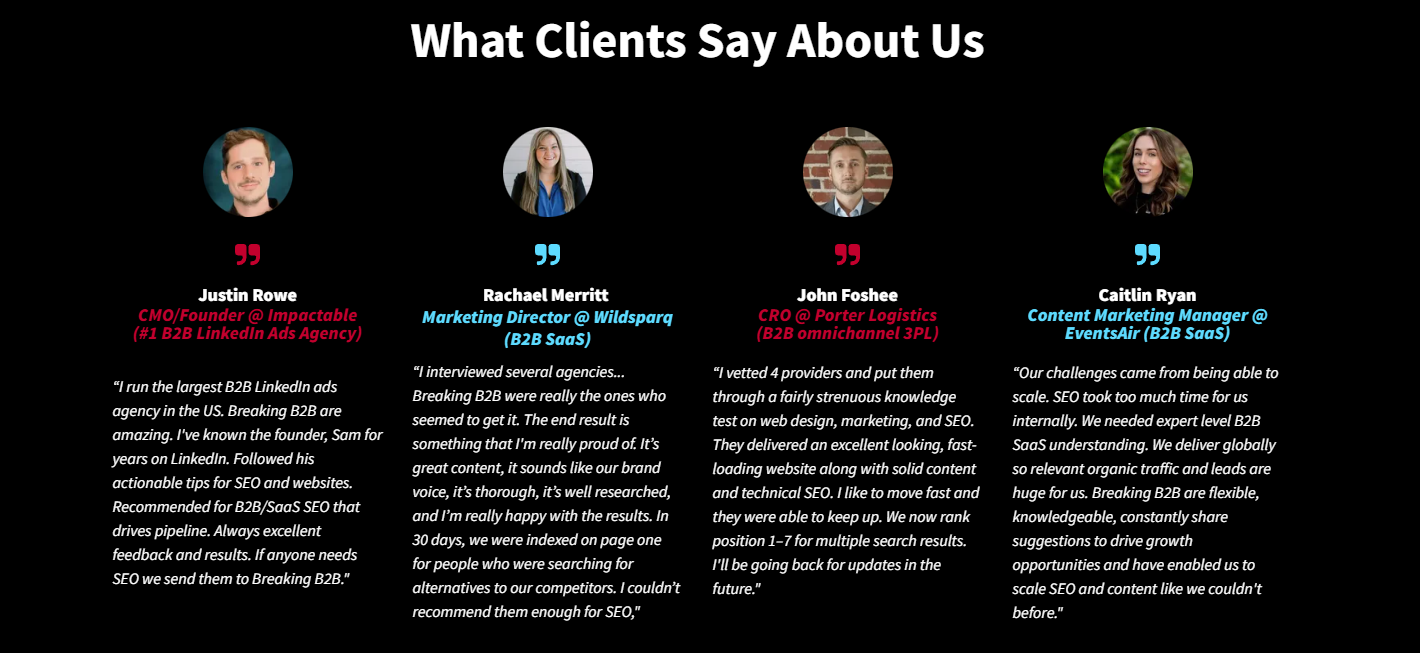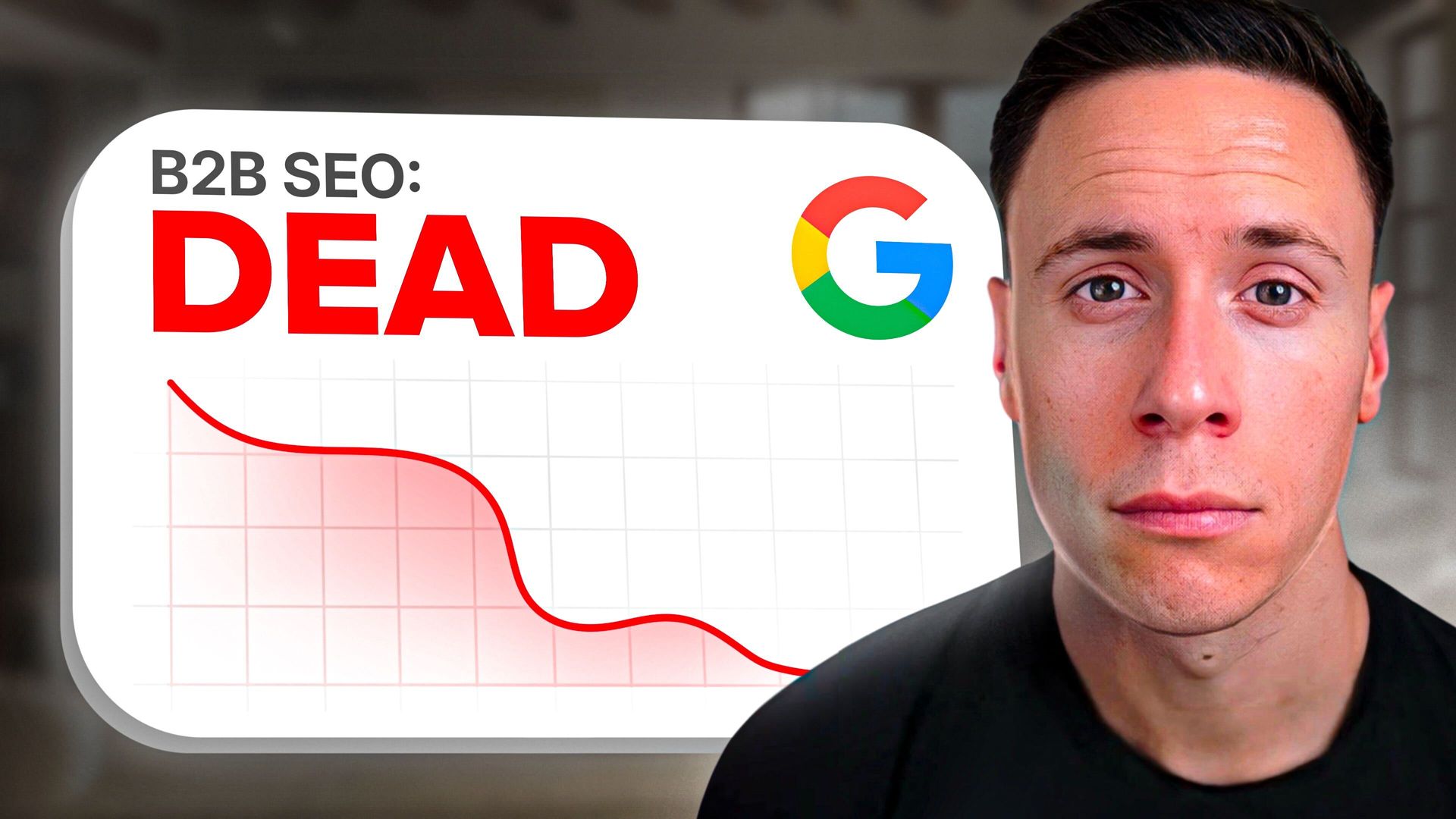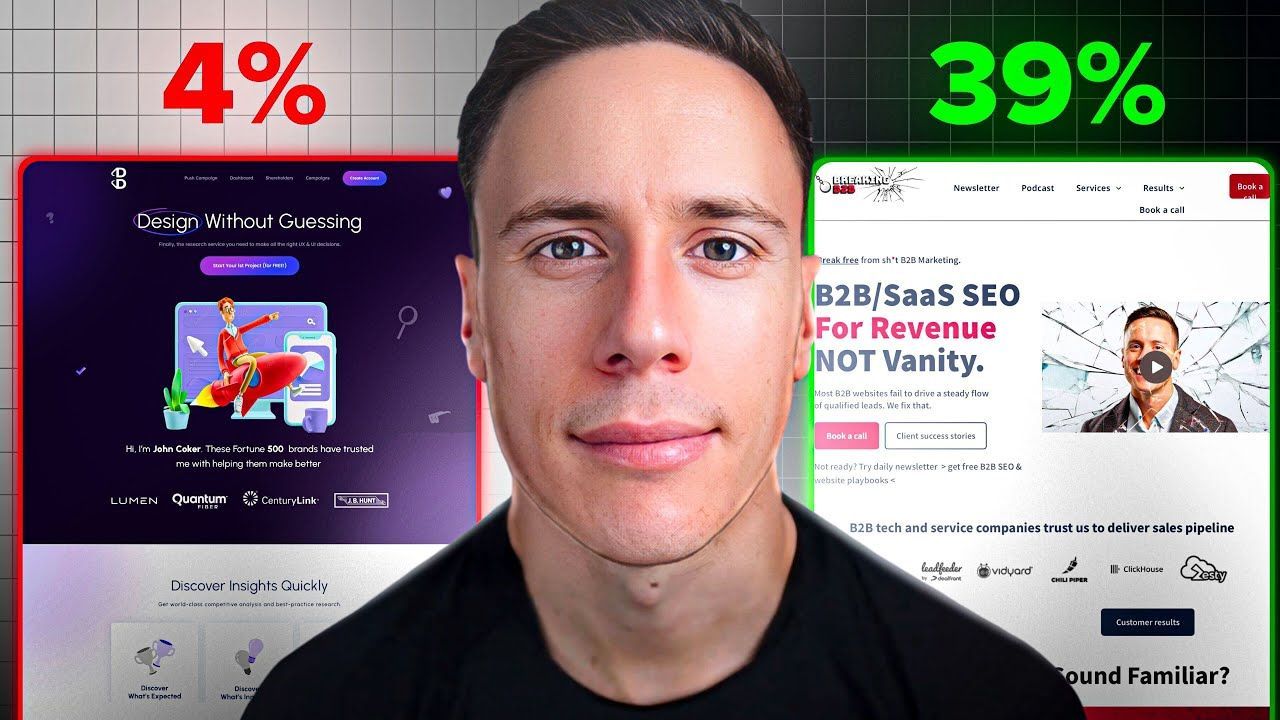Table of Contents
Ready To Grow Organic Pipeline & Revenue?
See if we can scale your organic pipeline from SEO as quick as 90 days.
Quick Summary
The Right SEO Strategy is Crucial for B2B SaaS Companies
B2B SaaS companies can't afford to rely on generic SEO tactics. Decision-makers search differently from consumers, and ranking alone won’t drive conversions.
To win organic traffic, you need more than just high-ranking keywords; you need a strategy built for long sales cycles, high-intent searches, and authority-driven content.
This means nurturing buyers, optimizing technical performance, and building trust at every stage. When done right, SEO becomes a predictable source of qualified leads, reducing reliance on paid ads and driving sustainable growth.
So, how do you get there? This
BreakingB2B guide breaks down exactly how to implement an SEO strategy that delivers real results for B2B SaaS companies.
Why Listen to Us?
At Breaking B2B, we specialize in B2B SaaS SEO that drives real business results, not just rankings. Our strategies are built for long sales cycles, high-intent buyers, and revenue growth. With proven SEO, content, and
web design expertise, we’ve helped B2B SaaS companies like
Payara and
Checkwriters turn organic traffic into qualified leads and sustainable growth.

What Is B2B SaaS Search Engine Optimization (SEO)?
When it comes to SEO, B2B SaaS businesses often make the mistake of focusing solely on traffic. B2B SaaS Search Engine Optimization (SEO) is about more than just attracting visitors. It involves optimizing a SaaS company's website, content, and overall digital presence. The goal is to improve rankings on search engines like Google, Bing, or Yahoo. Ultimately, SEO should drive qualified leads and business growth.
The goal is to increase organic traffic, attract high-quality leads, and ultimately drive business growth for the company. B2B (Business-to-Business) SaaS companies typically sell software solutions to other businesses. Therefore, their SEO strategies will target business decision-makers rather than individual consumers.
Here are some key elements of B2B SaaS SEO:
- Keyword Research: This involves identifying the most relevant and valuable search terms businesses use to find software solutions. Long-tail keywords (more specific phrases) often work well for B2B SaaS since the target audience usually searches for niche or specialized solutions.
- On-Page Optimization: This includes optimizing individual web pages by ensuring they have relevant keywords, compelling meta titles and descriptions, and a clear structure. Key pages include product landing pages, pricing pages, case studies, and blog posts.
- Content Strategy: In B2B SaaS, content is vital in establishing authority and educating potential customers. This can include whitepapers, ebooks, case studies, blogs, webinars, and customer testimonials, all of which should be optimized for SEO.
- Technical SEO: This focuses on the backend elements of a website, such as page speed, mobile-friendliness, site architecture, and ensuring search engines can easily crawl and index your site. A well-structured website with fast load times and mobile optimization is essential for ranking well.
- Link Building: Gaining backlinks from authoritative websites, particularly in the B2B and tech space, helps to boost your site's credibility and SEO rankings. This could involve guest blogging, partnerships, or collaborations with industry influencers.
- User Experience (UX): Google and other search engines prioritize user experience in their rankings. A well-designed, easy-to-navigate website with a fast, mobile-friendly interface will encourage visitors to stay longer, reducing bounce rates and increasing conversions.
- Local SEO: Optimizing for local search is important for B2B SaaS companies with a physical location or regional focus. This involves claiming Google My Business listings, obtaining local backlinks, and targeting location-based keywords.
-
Effective B2B SaaS SEO requires a strategic, long-term approach, focusing on traffic and attracting the right type of visitors who are more likely to convert into paying customers.
Why is B2B SaaS SEO Important?
B2B SaaS companies need qualified leads that convert to grow and generate consistent revenue. SEO is a long-term strategy that helps attract, nurture, and close the right buyers. Here’s why it matters:
- Targets High-Intent Buyers: Decision-makers search with purpose. They search for solutions to real problems, and SEO helps you show up exactly when they need you.
- Reduces Customer Acquisition Costs: Paying for every click adds up fast. SEO turns organic traffic into a long-term growth engine without investing in expensive ads.
- Builds Authority and Trust: Buyers won’t commit unless they trust you. Strong SEO content proves your expertise and makes it easier to win them over.
- Supports Long Sales Cycles: B2B buyers take their time. With SEO-driven content, you can keep your offers in their orbit and nurture them gradually until they’re ready to buy.
- Delivers Sustainable Growth: Unlike paid campaigns, SEO keeps working 24/7, generating leads long after you publish. With proper execution, it becomes a growth engine that compounds over time.
Next, let’s see how to execute a
B2B SaaS SEO plan that works.
How to Execute a B2B SaaS SEO Plan that Works
Step 1: Define SEO Goals
Before jumping into SEO, ask yourself: What does success look like for your SaaS business? Without clear goals, you’re just guessing. Whether you aim to generate leads, increase brand awareness, or drive more trial signups, your SEO strategy should align with those priorities.
At BreakingB2B, we usually start with a conversation—getting to know your business, audience, and key performance indicators (KPIs).
Actions to Take
- Outline Business Goals: Define what you want to achieve. For example, a SaaS company selling AI-powered CRM software may focus on attracting enterprise clients, increasing demo signups, and ranking for high-intent keywords like “best AI CRM for large teams.”
- Define Measurable Outcomes: Set clear success metrics, such as increasing organic traffic by 40%, ranking in the top 5 for competitive keywords, or boosting trial-to-paid conversions by 15%.
- Review Existing Strategies: Assess past SEO efforts to identify what’s working, what’s not, and where to refine your approach. Have you used paid ads? How effective were they?
- Set Realistic Timelines: Establish quarterly milestones to track progress and adjust strategies as needed.
-
This step isn’t just about numbers—it’s about ensuring
every SEO effort serves a purpose and leads to
scalable, repeatable results that drive business growth.
Step 2: Website and Content Analysis
Now that you’ve set your SEO goals, it’s time to evaluate your website and content. A thorough audit uncovers technical issues, content gaps, and missed optimization opportunities that might limit your organic growth.
Actions to Take
At BreakingB2B, we follow these steps to run an effective audit for our clients:
- Check Website and Analytics Tools: Ensure Google Search Console and Google Analytics are adequately set up and tracking key metrics.
- Review All Content Assets: Analyze landing pages, blog posts, and case studies to see what’s performing well and what needs improvement.
- Identify Key Conversion Pages: Focus on pricing pages, demo sign-up pages, and product feature pages to ensure they attract and convert the right visitors.
For example, if yours is a SaaS company that sees high blog traffic but low demo sign-ups, our audit might reveal weak internal linking, unclear CTAs, or missing bottom-funnel content. Fixing these issues improves user flow and drives more conversions.
With a clear website and content strategy in place, the next step is to find the right keywords to attract high-intent buyers.
Step 3: Conduct Comprehensive Keyword Research
Not all keywords drive revenue. B2B SaaS buyers search differently from consumers, using precise, solution-driven queries at different sales cycle stages. The goal is to attract decision-makers and convert organic traffic into revenue.
At this stage, it’s important to understand your target customer persona and their challenges. This helps uncover the exact search terms they use when looking for solutions.
Actions to Take
A comprehensive keyword research process includes:
- Identify Buyer Pain Points: Align keywords with real customer challenges to ensure content speaks directly to their needs.
- Target High-Intent Keywords: Research both short-tail and long-tail keywords, such as “best CRM for small businesses” or “project management SaaS with automation.”
- Consider Location-based Search Terms: Geo-targeted keywords can boost visibility if your SaaS targets specific industries or regions.
At BreakingB2B, keyword research is an integral part of our SEO strategy. We don’t just focus on high-volume, competitive keywords—instead, we prioritize low-volume, high-intent searches that your ideal buyers use. These ultra-specific keywords often lead to higher conversion rates because they attract customers who already know what they’re looking for.
For example, through comprehensive keyword research and content optimization,
we helped a client achieve a +182% increase in Page #1 rankings for demo-driving keywords within 6 months, driving significant organic growth.
Step 4: Create a Content Production Strategy
Now that you have the right keywords, you need content that moves buyers toward a decision. B2B SaaS purchases don’t happen on impulse—decision-makers research, compare, and weigh options before committing.
If your content doesn’t guide them at every step, they’ll choose a competitor instead. How do you ensure that doesn’t happen? By creating content that educates, builds trust, and converts.
Actions to Take
- Develop Pillar Content and Topic Clusters: Create pillar posts on core SaaS topics and interlink supporting content.
For example, if your SaaS product is a project management tool, write a pillar post about “Project Management Best Practices,” linking to blog posts on related topics like “Agile Methodologies” or “Task Delegation Strategies.”
- Publish High-quality Educational Resources: Whitepapers, eBooks, and in-depth guides help establish authority and nurture buyers through long sales cycles.
- Answer Common Questions in Blog Posts: Regularly address the search queries your target audience is asking, reinforcing trust and engagement.
- Leverage Customer Testimonials and Case Studies: Real-world success stories act as social proof, helping buyers gain confidence in your solution.
Content without a clear purpose loses buyers before they even consider your product. That’s why we take an SEO-first, sales-driven approach, ensuring every piece we create supports conversions.
And it works. For example, our content strategy helped a B2B SaaS client achieve #1 rankings for revenue-driving keywords within just a month of publishing,
boosting organic content rankings and driving increased traffic and click-throughs. This success led to a 3-month trial being extended to a 12-month contract.
Step 5: On-Page SEO Optimization
Now that you have content on your website, the next step is optimizing your pages to ensure search engines and users can easily understand and engage with your content.
Contrary to popular belief, on-page SEO isn’t about stuffing keywords. It’s about making every page clear, structured, and valuable. A well-optimized page helps search engines understand relevance and intent while guiding users toward the right information.
Actions to Take
- Review Website Structure: Ensure URLs, meta titles, and descriptions include target keywords and encourage clicks.
- Title Tags & Meta Descriptions: Keep them keyword-rich, compelling, and within 60 and 160 characters, respectively.
- Header Structure: Use H1 for the main topic and H2s/H3s for supporting sections to create a logical flow.
- Optimize Content Naturally: Incorporate relevant keywords into headers, paragraphs, and CTAs without overloading the text.
- Implement Internal Linking Strategies: Guide users and search engines with strategic internal links, prioritizing deep pages over just linking to the homepage.
A strong on-page SEO strategy ensures that ranking pages drive real business growth. At BreakingB2B, we continuously refine on-page elements based on performance data.
For example, if a page has high impressions but low clicks, we adjust titles and meta descriptions. If users bounce quickly, we improve content clarity and internal linking to keep them engaged.
Step 6: Ensure Strong Technical SEO
Technical SEO isn’t just about pleasing search engines—it’s about creating a fast, seamless experience that keeps decision-makers engaged. If pages load slowly or break on mobile, visitors won’t stick around, and potential leads will bounce before they even see your offer.
A well-optimized site builds trust, improves rankings, and increases conversions.
Actions To Take
Here are ways to ensure a strong technical SEO:
- Optimize for Mobile: Ensure your site has a responsive design that works flawlessly on all devices.
- Improve Website Speed: Compress images, enable caching, and use a content delivery network (CDN) to keep load times under two seconds.
- Fix Broken Links and Redirects: Identify 404 errors, duplicate content, and outdated redirects to prevent search engine penalties.
- Implement Schema Markup: Add structured data for rich snippets like pricing, FAQs, or customer reviews, making search listings more engaging and clickable.
Many B2B SaaS companies struggle with complex site structures, slow pages, and indexing issues—all of which block organic growth. Our comprehensive SaaS SEO strategy solves these problems.
Even better, we offer
B2B SaaS website design as part of our services. We’ve helped
SaaS brands
rebuild slow, underperforming sites into high-converting, SEO-friendly assets. The result? More visibility, more engagement, and more conversions.
Step 7: Build Authority with Backlinks
Credibility is a key factor in SEO rankings. Search engines prioritize sites that other reputable sources link to, but in B2B SaaS, backlink quality matters more than quantity.
Spammy or irrelevant links can hurt your rankings—what you need are high-authority backlinks from industry-relevant sources that influence decision-makers.
Actions To Take
- Make Guest Contributions: Write for respected industry blogs to position yourself as an expert while earning backlinks, especially on sites your buyers read.
- Produce Podcasts and Interviews: Featuring executives on niche podcasts creates exposure and trust while offering unique link opportunities from show notes and guest bios.
- Compile Data-Driven Reports: Publish original research and insights—these get referenced in articles, earning natural backlinks from industry publications.
- Enter into Strategic Partnerships: Collaborate with complementary SaaS brands for co-marketing opportunities, shared content, case studies, and reciprocal links.
At BreakingB2B, we use podcasts as part of our SaaS SEO strategy, creating authoritative, shareable content that attracts backlinks, strengthens brand credibility, and fuels long-term SEO growth.
We also conduct regular backlink audits, removing toxic links and ensuring a sustainable, high-quality link profile that builds long-term authority and rankings.
Step 8: Local SEO
If your B2B SaaS serves specific geographic areas, local SEO is essential to ensure your business appears in location-based searches. Whether you have a physical office, region-specific offerings, or localized service areas, optimizing for local visibility helps attract the right audience.
Actions to Take
- Claim and Optimize Your Google My Business Profile: If your SaaS has a physical office or offers region-specific services, ensure your business listing is accurate, complete, and regularly updated.
- Use Location-Based Keywords: Optimize your website for searches like “SaaS for [city/region]” or “best CRM in [state].”
- Get Listed in Local Directories: Submit your business to relevant local business directories, ensuring consistency in your NAP (Name, Address, Phone Number) information.
- Encourage Local Reviews: Ask satisfied customers from your service area to leave Google and industry-specific reviews, helping to boost credibility and rankings.
For instance, if a B2B SaaS company offering compliance software wants to reach highly regulated industries, they can optimize for location-based keywords and claim their Google My Business listing. If done well, this could boost their local visibility significantly in target regions and attract more qualified leads.
Step 9: Measure, Analyze, and Continuously Improve
SEO isn’t a one-time task—it’s an ongoing process of testing, refining, and adapting. Search rankings shift, competitors evolve, and algorithms change.
Are visitors taking action (demo requests, sign-ups, downloads)? Are high-intent pages ranking where they should? Are prospects staying, reading, and clicking deeper?
You must track performance, analyze data, and make continuous improvements to stay ahead.
Actions to Take
- Track Performance Metrics: Use Google Analytics and Google Search Console to monitor organic traffic, keyword rankings, and bounce rates.
- Measure Lead Generation Impact: Analyze sign-ups, trials, and conversions to see how SEO translates into business growth.
- Identify User Behavior Trends: Use heatmaps and session recordings to detect friction points and improve site navigation.
- Keep Content Fresh: Regularly update high-traffic pages to maintain relevance and authority.
- Conduct SEO Audits: Perform quarterly reviews to identify new optimization opportunities and address technical issues.
Analyzing what moves the needle and optimizing accordingly ensures that your strategy continues to deliver measurable business growth over time.
Best Practices for B2B SaaS SEO
Beyond following a process, you must refine, adapt, and execute strategically to drive real results. These best practices will help you get there:
- Prioritize Bottom-Funnel Optimization: Optimize product pages, case studies, and competitor comparisons to convert high-intent buyers. For instance, if your page ranks for “best AI automation tools,” include a strong CTA, pricing insights, and differentiation factors to drive action.
- Leverage First-Party Data for SEO Insights: Search volume doesn’t always reflect buyer intent. Use CRM data, sales calls, and support tickets to find recurring pain points. Even low-volume keywords, like “security compliance in SaaS,” can attract highly relevant, conversion-ready traffic.
- Integrate SEO with Demand Generation: SEO should align with paid ads, outbound efforts, and sales enablement. If PPC data reveals high-converting keywords, refine organic content. Retarget SEO visitors with account-based marketing (ABM) to keep them engaged beyond their initial search.
- Optimize for Branded Search Queries: Buyers often search for “[Your SaaS] vs. Competitor” or “Is [Your SaaS] worth it?” before deciding. Publish comparison pages, highlight testimonials, and ensure review sites link back to your website to own these searches.
- Develop Scalable Content Frameworks: SEO evolves with industry trends and product updates. Use modular content structures that allow quick updates. A “Best Tools” list should be designed for easy annual updates to maintain relevance.
- Stay Adaptive to Search Intent Shifts: Google’s algorithm and buyer behavior change constantly. Monitor content performance and adjust accordingly. If an informational page starts ranking for transactional queries, update it with CTAs, pricing insights, or case studies to boost conversions.
-
By following these advanced best practices, B2B SaaS companies can ensure their SEO strategy isn’t just about rankings—but about sustained growth, lead generation, and revenue impact.

Driving Real Growth with Expert-Led B2B SaaS SEO
B2B SaaS SEO isn’t just about rankings—it’s about driving real business growth. From targeting high-intent keywords to optimizing technical performance and building authority, every step plays a role in turning search visibility into revenue. While automation can help, a strategic, human-led approach delivers the best results—and that’s where expert guidance makes the difference.
At Breaking B2B, we specialize in SEO, web design, and content strategies tailored for B2B SaaS companies. We don’t just improve rankings—with a proven, data-driven approach, we help businesses attract, engage, and convert the right buyers.
Ready to turn SEO into a true growth engine?
Book a call today.







